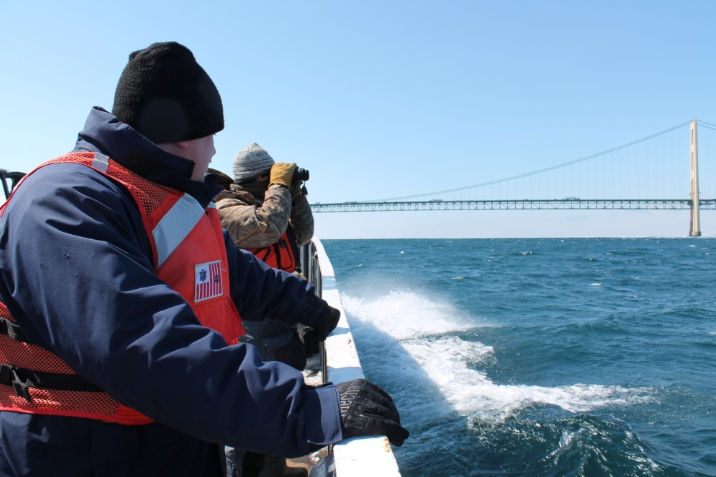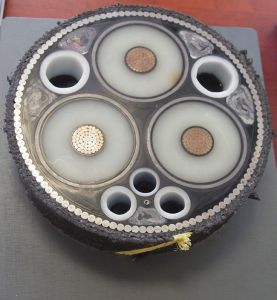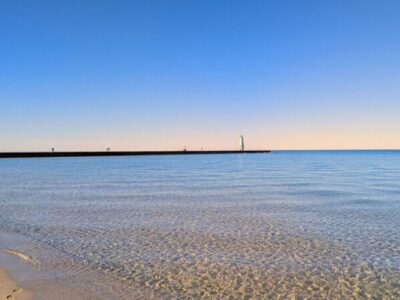
Press Release from the United States Coast Guard
| News Release |
U.S. Coast Guard 9th District Great Lakes |
UPDATE 3: Coast Guard, partners respond to spill in Straits of Mackinac
MACKINAW CITY, Mich. – A Coast Guard marine science technician and an environmental quality analyst for Michigan’s Department of Environmental Quality surveyed the Straits of Mackinac onboard a vessel this afternoon. The responders did not identify any mineral oil sheens, signs of pollution, or adverse impacts to the environment or wildlife.
Members of the U.S. Department of Agriculture are deploying to the scene to survey the area for any wildlife that may be affected by the mineral oil spill.
The National Oceanic and Atmospheric Administration’s new calculation for the trajectory of the spill is to the east and northeast of the utility line, due to changing weather conditions. The entities responsible for the operation of the water intakes in the surrounding communities have been notified of the change in trajectory, however there is still low risk to drinking water and the environment due to the product’s low toxicity and dilution in the waterway. The mineral oil is not known to be leaking from the source at this time, and the estimated amount of oil spilled remains at 600 gallons.
In the mineral oil, there is a dielectric fluid that contains a benzene compound.
“The benzene molecule is known to cause cancer but these larger chemicals (benzene compounds in the dielectric fluid) have not been classified as causing cancer,” said Edward Primeau, an industrial hygienist from the Coast Guard Atlantic Strike Team.
Crews continue to extract the oil from the affected two utility lines.
Previous press releases can be viewed here.
For more information, contact the Point Le Barbe Response at the Joint Information Center via email at PointLeBarbeResponseJIC@gmail.com or the Coast Guard Ninth District Public Affairs at (216) 310-2608.
-USCG-
As we’ve been reporting on greatlakesnow.org, a coolant fluid spill in Michigan’s Straits of Mackinac has prompted the creation of a multi-agency command post in Mackinaw City.
The spill of what’s called ‘di-electric’ fluid occurred in two underwater power lines that extend from the Upper Peninsula to the Lower Peninsula in the Straits of Mackinac. The lines are owned by American Transmission Company (ATC) headquartered in Pewaukee, Wisconsin.
ATC Spokesperson Jackie Olson tells Great Lakes Now the lines have been shut down and the spill has topped out at just under 600 gallons. She says no further fluid is leaking into the spot where Lake Michigan and Lake Huron join near the Mackinac Bridge.
Even though the spill occurred on Sunday night, the U.S. Coast Guard was not notified of the incident until Monday night. No specific cause of the spill has been identified.
DPTV’s Great Lakes Now interviewed the U.S. Coast Guard’s Lt. Rachel Wellman via Skype from the Mackinaw City Command Post about how the spill was discovered, when the Coast Guard was called in to help, what the spilled fluid contains, whether wildlife, water or humans are being threatened, what caused the spill, and whether drinking water intakes will be affected.
Lt. Wellman confirms that the spilled coolant fluid contains the toxic component Benzene, a volatile organic compound which is a known carcinogen, which could be harmful to aquatic life. Lt. Wellman calls this discovery “alarming”, however she says dilution minimizes the potential for damage to wildlife.
Lt. Wellman says there’s still no known cause of the spill.
2 Comments
-
This story alleging that Benzene was spilled at the Mackinac Strait from the submerged electric cables is false. The company has identified the liquids spilled at Dielectric Fluid 45. Here is data and MSDS information on DF 45:
http://soltexinc.com/wp-content/uploads/2016/10/TDS_DF-45-100-500-3000-FINAL.pdf
http://soltexinc.com/wp-content/uploads/2016/10/SDS_DF-45-NAMEX.pdfAccording to the MSDS, Benzene is NOT a listed constituent of DF 45. If it were it would have to be listed separately as “Benzene” alone with a Chemical Abstract Service number of 71-43-2, and it is NOT shown as such.
C10-16 and C10-13 Alkylated benzene compounds are NOT Benzene. They are chemical compounds with up to 13 or 16 carbon alkyl groups attached to a benzene ring….making them distinct from simple benzene molecules alone. Such compounds have different chemical and toxicology properties from the lighter molecular weight, simpler benzene molecules.
This is not the first time Great Lakes Now has published scientifically erroneous coverage of environmental issues. Your entire “48217 is the most polluted area of Michigan” is similarly flawed as being completely without any scientific basis in air quality and pollution health effects science.
For a big grant-funded operation like you’re running, there is no excuse for your organization to be engaging in propagation of false junk science claims.
-
Coast Guard industrial hygienist verifies that “benzene compounds” were released….not benzene:
“In the mineral oil, there is a dielectric fluid that contains a benzene compound.”
“The benzene molecule is known to cause cancer but these larger chemicals (benzene compounds in the dielectric fluid) have not been classified as causing cancer,” said Edward Primeau, an industrial hygienist from the Coast Guard Atlantic Strike Team. ”
https://content.govdelivery.com/accounts/USDHSCG/bulletins/1e78d8e





